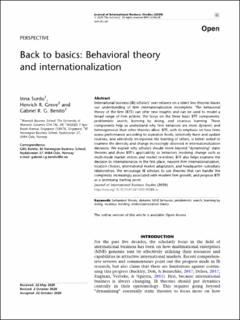Back to basics: Behavioral theory and internationalization
Peer reviewed, Journal article
Published version
Permanent lenke
https://hdl.handle.net/11250/2992564Utgivelsesdato
2020Metadata
Vis full innførselSamlinger
- Scientific articles [2181]
Originalversjon
10.1057/s41267-020-00388-wSammendrag
International business (IB) scholars’ over-reliance on a select few theories leaves our understanding of firm internationalization incomplete. The behavioral theory of the firm (BTF) can offer new insights and can be used to model a broad range of firm actions. We focus on the three basic BTF components:
problemistic search, learning by doing, and vicarious learning. These components help us understand why firm behaviors are more dynamic and heterogeneous than other theories allow. BTF, with its emphasis on how firms assess performance according to aspiration levels, selectively learn and update routines, and selectively incorporate the learning of others, is better suited to examine the diversity and change increasingly observed in internationalization decisions. We explain why scholars should move beyond ‘‘dynamizing’’ static theories and show BTF’s applicability to behaviors involving change such as multi-mode market entries and market re-entries. BTF also helps examine the decision to internationalize in the first place, nascent firm internationalization, location choices, international market adaptation, and headquarter–subsidiary relationships. We encourage IB scholars to use theories that can handle the complexity increasingly associated with modern firm growth, and propose BTF as a promising starting point.
